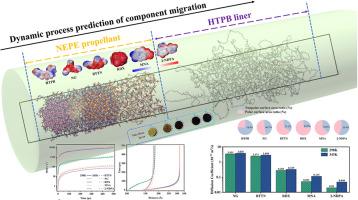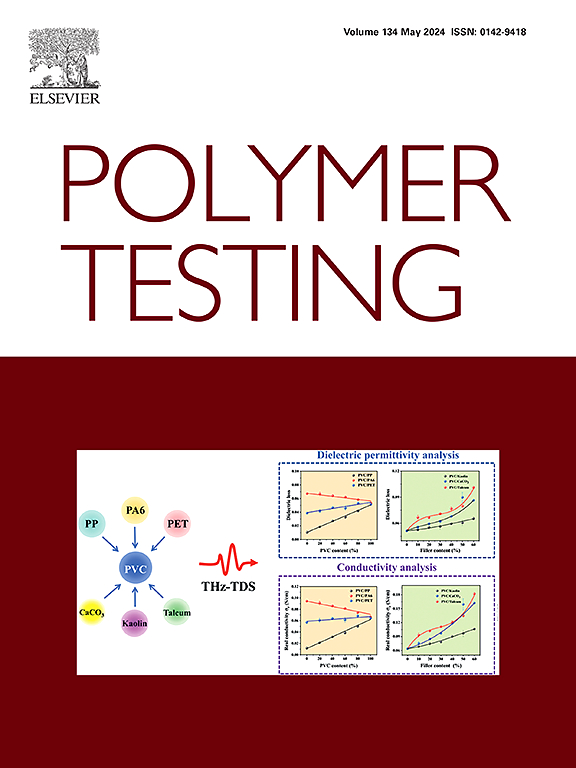Analysis and prediction for dynamic migration behavior of NEPE propellant/liner interface layer full components
IF 5
2区 材料科学
Q1 MATERIALS SCIENCE, CHARACTERIZATION & TESTING
引用次数: 0
Abstract
The migration behavior of nitrate ester-plasticized polyether (NEPE) propellant components significantly impacts safety. Experimentally observing the migration process is challenging and time-consuming. This study employed molecular dynamics (MD) methods to simulate a molecular model of the NEPE propellant/liner interface layer, enabling the prediction of component migration behavior. We visualized the migration process of all propellant components and studied the interface layer components' migration patterns, diffusion coefficients, and concentration gradient distributions. The contents of migrated components of the propellant and liner at different accelerated aging times at 70 °C were determined using high-performance liquid chromatography (HPLC), and the simulation patterns were compared with experimental observations. The results indicate that the migrated components in the propellant mainly consist of nitrate esters (Nitroglycerin, abbreviated as NG, and Butanetriol Trinitrate, abbreviated as BTTN), stabilizers (NMethylnitroaniline, abbreviated as MNA, and 2-Nitrodiphenylamine, abbreviated as 2-NDPA), and solid component (Hexahydro-1,3,5-trinitro-1,3,5-triazine, abbreviated as RDX). The migration process is primarily dominated by the substantial migration of nitrate esters, which is a key factor contributing to the degradation of propellant performance during storage. The migration process can be divided into three stages: swift migration, steady slow migration, and migration equilibrium. The diffusion coefficients are ranked from most significant to most minor as NG > BTTN > RDX > MNA > 2-NDPA. Three migration stages consistent with the simulation process were observed using HPLC, and the migration behavior of nitrate esters aligned with simulation patterns. Our designed full-component model can qualitatively predict component migration behavior. Additionally, a faster diffusion coefficient does not necessarily lead to a greater amount of migration. We employed MD simulations combined with density functional theory (DFT) calculations to explain this phenomenon and found that intermolecular interactions may influence the diffusion coefficient. At the same time, the migration amount is highly correlated with molecular polarity. Therefore, increasing the molecular polarity difference between easily migrating components and liner materials is a beneficial strategy for slowing the migration process and enhancing the storage safety of propellants.

分析和预测 NEPE 推进器/衬垫界面层全组件的动态迁移行为
硝酸酯塑化聚醚(NEPE)推进剂成分的迁移行为对安全性有重大影响。对迁移过程进行实验观察既具有挑战性又耗费时间。本研究采用分子动力学(MD)方法模拟了 NEPE 推进剂/衬垫界面层的分子模型,从而能够预测组件的迁移行为。我们将所有推进剂成分的迁移过程可视化,并研究了界面层成分的迁移模式、扩散系数和浓度梯度分布。我们使用高效液相色谱法(HPLC)测定了推进剂和衬垫在 70 ℃ 下不同加速老化时间的迁移成分含量,并将模拟模式与实验观察结果进行了比较。结果表明,推进剂中迁移的成分主要包括硝酸酯类(硝化甘油,简称 NG 和丁三醇三硝酸酯,简称 BTTN)、稳定剂(甲基硝基苯胺,简称 MNA 和 2-硝基二苯胺,简称 2-NDPA)和固体成分(六氢-1,3,5-三硝基-1,3,5-三嗪,简称 RDX)。迁移过程主要以硝酸酯的大量迁移为主,这是导致推进剂在储存期间性能下降的一个关键因素。迁移过程可分为三个阶段:快速迁移、稳定缓慢迁移和迁移平衡。扩散系数从大到小依次为 NG > BTTN > RDX > MNA > 2-NDPA。使用高效液相色谱法观察到与模拟过程一致的三个迁移阶段,硝酸酯的迁移行为与模拟模式一致。我们设计的全组分模型可以定性地预测组分迁移行为。此外,扩散系数越快并不一定导致迁移量越大。我们采用 MD 模拟结合密度泛函理论(DFT)计算来解释这一现象,发现分子间的相互作用可能会影响扩散系数。同时,迁移量与分子极性高度相关。因此,增加易迁移成分与内衬材料之间的分子极性差异是减缓迁移过程和提高推进剂储存安全性的有效策略。
本文章由计算机程序翻译,如有差异,请以英文原文为准。
求助全文
约1分钟内获得全文
求助全文
来源期刊

Polymer Testing
工程技术-材料科学:表征与测试
CiteScore
10.70
自引率
5.90%
发文量
328
审稿时长
44 days
期刊介绍:
Polymer Testing focuses on the testing, analysis and characterization of polymer materials, including both synthetic and natural or biobased polymers. Novel testing methods and the testing of novel polymeric materials in bulk, solution and dispersion is covered. In addition, we welcome the submission of the testing of polymeric materials for a wide range of applications and industrial products as well as nanoscale characterization.
The scope includes but is not limited to the following main topics:
Novel testing methods and Chemical analysis
• mechanical, thermal, electrical, chemical, imaging, spectroscopy, scattering and rheology
Physical properties and behaviour of novel polymer systems
• nanoscale properties, morphology, transport properties
Degradation and recycling of polymeric materials when combined with novel testing or characterization methods
• degradation, biodegradation, ageing and fire retardancy
Modelling and Simulation work will be only considered when it is linked to new or previously published experimental results.
 求助内容:
求助内容: 应助结果提醒方式:
应助结果提醒方式:


